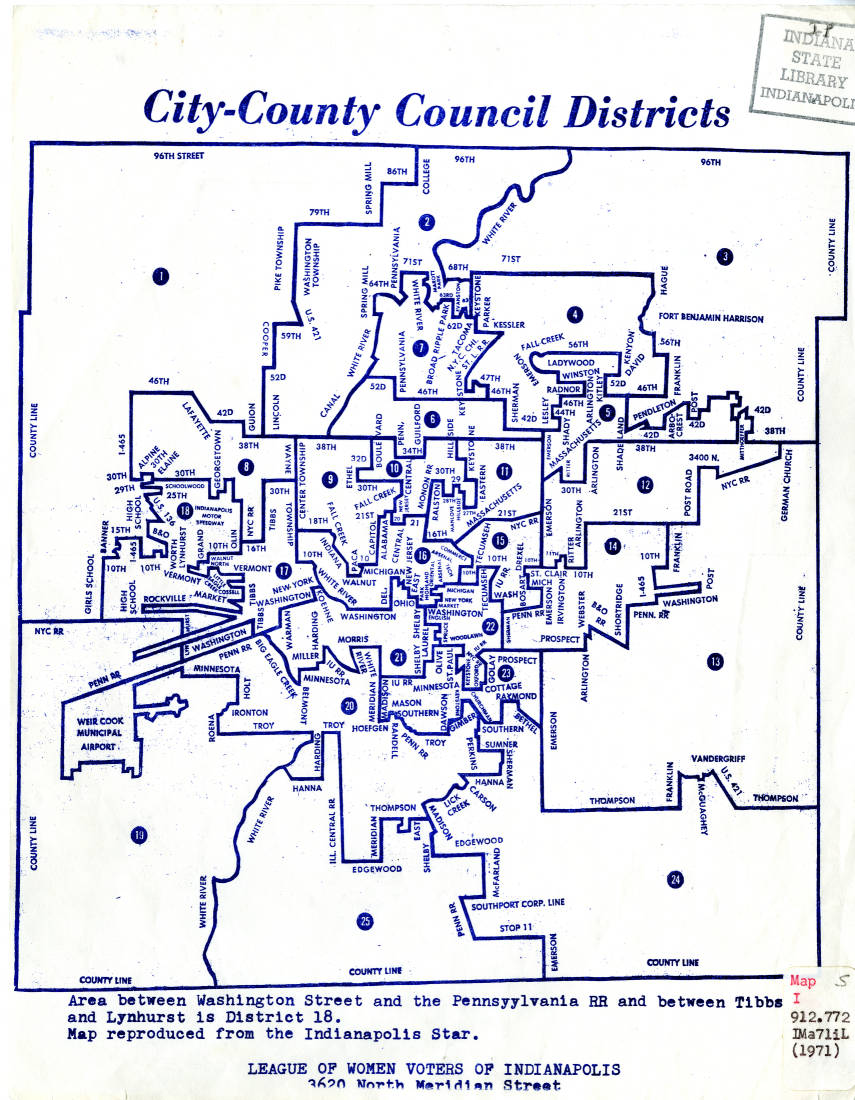The City-County Council is a legislative body for Marion County. When took effect in in 1970, the members of the former Indianapolis Common Council and the Marion County Council combined to form a new City-County Council. The first full 29-member City-County Council was elected in 1971.

Until the Indiana General Assembly voted to change the structure of the City-County Council in 2013, 25 councilors were elected from districts within Marion County, while 4 were elected at large and provided countywide representation. With the 2015 election, the council’s size was reduced to 25 councilors who must reside in the districts they represent. The boundaries of those districts are decided by the City-County Council after each decennial census, and the districts are required to be equal in population. The 25 councilors are elected in municipal election years and serve four-year, renewable terms.
All councilors must be residents of Marion County, U.S. citizens, and at least 21 years old. The council is the legislative body for Marion County as well as for the city of Indianapolis. Its formal powers and responsibilities include; review and approval of ordinances or resolutions pertaining to the city of Indianapolis or Marion County; review and approval of the budgets of Indianapolis and Marion County government, as well as some of the independent municipal corporations within the county; review and approval of all appropriations ordinances for city and county government departments; appoint members of several local government boards and commissions; and, confirm or reject the mayor’s nominees to deputy mayor and department director positions.
The whole council meets on Monday evenings at least once and usually twice per month. Each year the council establishes a schedule of meetings for the coming year. Council meetings are open to the public and are available for public viewing. To perform its tasks the City-County Council relies on officers, committees, and staff assistance. Four councilors are chosen each year to fill the offices of president, vice president, majority leader, and minority leader.
The president and vice president are elected by a vote of all councilors. The president presides at council meetings and signs all ordinances and resolutions passed by the council.
The vice president performs these duties in the president’s absence. The majority leader and minority leader are chosen by the members of their respective political parties on the council and preside over meetings of their party caucuses.
The City-County Council has three permanent committees and nine standing committees. The three permanent committees are the Committee of the Whole, consisting of all councilors; the Committee on Committees, which assigns councilors to the other committees; and the Committee on Rules and Public Policy, which considers changes in council rules or operations. The nine city-county government standing committees include Administration and Finance, Community Affairs, Education, Ethics, Metropolitan and Economic Development, Municipal Corporations, Parks and Recreation, Public Safety and Criminal Justice, and Public Works. In addition, the Commission on Environmental Sustainability has recently been established as a study commission but not a standing committee.
The nine standing committees meet to consider proposed ordinances or resolutions within their jurisdiction. They are required to act on any proposal within 45 days of its referral. Each standing committee has at least three members, with one member designated as committee chair by the council president. Committee meetings are held regularly and are open to the public and to other councilors.
Some councilors also serve on Special Service District Councils that correspond with the Police and Fire Special Service Districts and the Solid Waste Collection and Disposal Special Service Districts. Councilors serve on these councils if the corresponding contains a majority of the residents in their electoral districts.
The City-County Council is required by state law to have a clerk who is approved by the full Council. Local ordinance provides for the following staff positions to support the work of the Council: two assistant clerks, one appointed by each caucus; four positions appointed by the president which include general counsel, director of public affairs, policy director, and chief financial officer; three constituent relations liaisons; three constituent services liaisons; and a fiscal and policy analyst.
The public assembly room of the was named in honor of , who served as council president from 1975 to 2002.

Help improve this entry
Contribute information, offer corrections, suggest images.
You can also recommend new entries related to this topic.